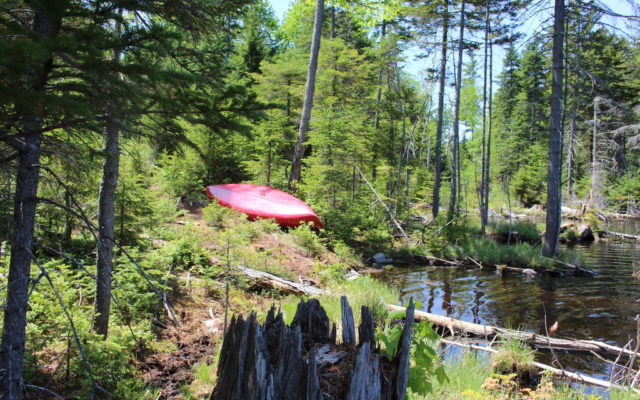
Do you stash canoes at remote Maine ponds? If so, I want to hear from you
For many Mainers, “going fishing” means heading to camp, hopping on a boat and heading out on a busy lake or pond. For others, it might entail a quiet walk beside a babbling brook, where each corner leads to another set of productive pools.
And for the more adventurous among us, “going fishing” involves long hikes into remote ponds, where we borrow a canoe — or, perhaps, have one of our own canoes stashed — and spend the day all alone in the Maine wilderness.
Around the state, there are hundreds of places like that, and in some cases anglers have stored dozens of canoes on the shorelines of those ponds, on land they don’t own.
That’s not necessarily a problem, and actually leads to a phenomenon that many folks “from away” find remarkable: Anglers on those ponds often carry a paddle and a life jacket to their fishing destinations, confident that they’ll find a canoe that’s not locked to a tree, and therefore fair game to borrow.
There are a few unwritten rules on those ponds, however. After borrowing a canoe, those anglers are expected to leave the canoe as they found it. And should the canoe’s owner show up to use his or her boat, ignoring their pleas would be bad form indeed.
On many of those ponds, the identity of the owners of those stashed boats is a mystery. Many canoes are marked with an owner’s name and phone number, but many others aren’t.
One potential issue is that one person’s convenience can be another person’s clutter — dozens of boats chained to trees on an otherwise pristine shoreline. More serious: If the owner of a canoe stops fishing, or dies, the canoe can sit in the woods for years, rotting away.
For years, legislators have floated plans to require registration of those boats, and in some cases, large private landowners have initiated similar programs to make sure that phantom boats don’t sit unused, growing moss.
Over the past several weeks, I’ve talked to several people about the issue of canoes and boats stashed on others’ land. Some say there’s a problem. Others say the practice is one of the coolest things about living — and fishing — in Maine.
So what do you think? Problem? Much ado about nothing? And if you think there’s a problem, do you see a simple solution to implement?
I’ll be writing a story about the issue in the near future, and if you’d like to share thoughts, you can reach me at jholyoke@bangordailynews.com. When you respond, make sure you tell me a bit about yourself: Do you have canoes stashed at ponds? Have you used others’ canoes? Is the whole premise foreign to you?
Thanks in advance for any help you can provide.
Any-deer update
If you want to chase deer that aren’t sporting antlers this fall, it’s time to enter the state’s annual any-deer permit lottery.
The Maine Department of Inland Fisheries and Wildlife opened its permit lottery last week, and a total of 84,745 permits will be allotted this year. That’s an all-time record.
The top Wildlife Management Districts for any-deer permits: WMD 23 (12,375 permits to be allotted), WMD 22, (11,000 permits), WMD 21 (10,500 permits) and WMD 17 (10,000 permits).
Entry into the lottery is free, and the application can be found here: https://www20.maine.gov/online/any_deer_lottery.
Applications must be filled out by 11:59 p.m. Aug. 15. The drawing will be held Sept. 7.
The DIF&W uses any-deer permits to help manage the state’s deer population. Biologists use the system to increase or decrease the number of breeding female deer in certain areas.
Holyoke can be reached at jholyoke@bangordailynews.com or 990-8214. Follow him on Twitter: @JohnHolyoke.